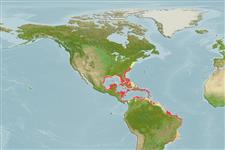Environment: milieu / climate zone / depth range / distribution range
Écologie
marin récifal; profondeur 3 - 70 m (Ref. 13121), usually 5 - 20 m (Ref. 13121). Tropical; 41°N - 29°S, 100°W - 28°W (Ref. 55200)
Western Atlantic: Massachusetts, USA to Santa Catarina, Brazil (Ref. 57756), including the Gulf of Mexico and Caribbean Sea. Eastern Central Atlantic: St. Paul's Rocks (Ref. 13121).
Length at first maturity / Taille / Poids / Âge
Maturity: Lm 12.4 range ? - ? cm
Max length : 16.0 cm TL mâle / non sexé; (Ref. 9710)
Épines dorsales (Total) : 12; Rayons mous dorsaux (Total) : 19 - 21; Épines anales: 3; Rayons mous anaux: 16 - 17. With two broad black bars on side of body and a third bar basally in soft portion of dorsal fin which extends onto caudal peduncle; broad black submarginal bands in the median fins; pelvic fins black except for the spine (Ref. 13442).
Maximum depth from Ref. 126840. Inhabit coral reefs. Occur singly or in pairs. Feed on polychaete worms, coral polyps, crustaceans and mollusk eggs. Oviparous (Ref. 205), monogamous (Ref. 52884). Form pairs during breeding (Ref. 205). Adults may form plankton-feeding aggregations of up to 20 individuals, and occasionally clean other reef fishes which join the group, such as grunts, parrotfishes and surgeon fishes. (Ref: 40093). Generally common (Ref. 9710).
Life cycle and mating behavior
Maturities | Reproduction | Spawnings | Egg(s) | Fecundities | Larves
Distinct pairing (Ref. 205). Monogamous mating is observed as both obligate and social (Ref. 52884).
Allen, G.R., 1985. Butterfly and angelfishes of the world. Vol. 2. 3rd edit. in English. Mergus Publishers, Melle, Germany. (Ref. 4858)
Statut dans la liste rouge de l'IUCN (Ref. 130435)
Menace pour l'homme
Harmless
Utilisations par l'homme
Pêcheries: commercial; Aquarium: Commercial
Outils
Articles particuliers
Télécharger en XML
Sources Internet
Estimates based on models
Preferred temperature (Ref.
123201): 25 - 28, mean 27.2 °C (based on 158 cells).
Phylogenetic diversity index (Ref.
82804): PD
50 = 0.5000 [Uniqueness, from 0.5 = low to 2.0 = high].
Bayesian length-weight: a=0.02239 (0.01442 - 0.03475), b=3.02 (2.89 - 3.15), in cm total length, based on LWR estimates for this species & Genus-body shape (Ref.
93245).
Niveau trophique (Ref.
69278): 3.5 ±0.2 se; based on diet studies.
Résilience (Ref.
120179): Haut, temps minimum de doublement de population inférieur à 15 mois (Preliminary K or Fecundity.).
Fishing Vulnerability (Ref.
59153): Low vulnerability (10 of 100).
Nutrients (Ref.
124155): Calcium = 101 [52, 160] mg/100g; Iron = 0.827 [0.486, 1.386] mg/100g; Protein = 18.7 [17.5, 19.8] %; Omega3 = 0.13 [0.08, 0.21] g/100g; Selenium = 35.6 [19.6, 67.4] μg/100g; VitaminA = 50.6 [14.7, 171.2] μg/100g; Zinc = 1.36 [0.92, 1.97] mg/100g (wet weight);
